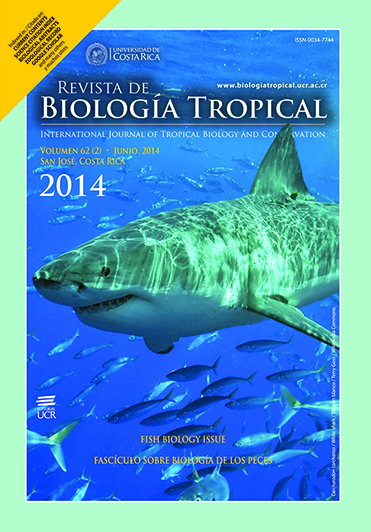Abstract
The suprabenthos or hyperbenthos is the macrofaunal assemblage of small-sized organisms that interact for some time in the benthic boundary layer. Information about the taxonomic composition and role of suprabenthic species, especially in littoral zones, is scarce and scattered. This work attempts to contribute alleviate this problem. We analyze the temporal and spatial variations of suprabenthic assemblages in the swash-zone from four beaches of the littoral coast of Venezuela. For each beach, two sites were chosen, and special attention was given to water and sediment characteristics. 12 environmental variables were measured: Dissolved oxygen, oxygen saturation percentage, pH, salinity, surface temperature, total, organic and inorganic suspended solids, total organic carbon, organic matter in sediment, grain size of sediment, and amount of dragged material of sample. All faunal samples were taken on a monthly basis during 2011; these were extracted using a manual suprabenthic sledge towed parallel to the shoreline. Samples were sorted and identified to their lowest possible taxonomic level. A total of 24 141 specimens (mean abundance: 26.16±55.35ind./m2) belonging to 21 taxonomic groups were identified. Analysis suggests that seasonality does not explain observed changes either in fauna or environmental variables. It was found that suprabenthic assemblages, total suprabenthos density, richness and environmental variables changed in a dissimilar fashion between months and beaches. The most frequent groups were amphipods and decapods; and at the species/categories level post-larval shrimp (Penaeidae), Grapsidae crab megalopae and Arenaeus cribarius megalopae were common. Dissimilarity between months in each beach was primarily explained by the abundance of amphipods, ctenophores, decapods and mysids. For particular months and selected beaches very high abundances of ctenophores were found. This group dominated the sample even though it is not usually a representative group in suprabenthos. Samples showed low correlations between suprabenthos and environmental variables. A somewhat stronger correlation could be established between water characteristics and dragged material abundance. The studied suprabenthos assemblage was found to have high taxa richness and very dynamic behaviour at spatial and temporal scale. Further analysis suggested that there is no evident pattern of distribution and that causality can not be directly attributed to temporal variation only. Possibly there is an influence of a synergy of environmentals or biological factors, rather than a single variable. The species Americamysis bahia and Americamysis taironana are reported for the first time in Venezuela. This study represents the first ecological research of the suprabenthos in the Caribbean region.
Comments

This work is licensed under a Creative Commons Attribution 4.0 International License.
Copyright (c) 2014 Revista de Biología Tropical






